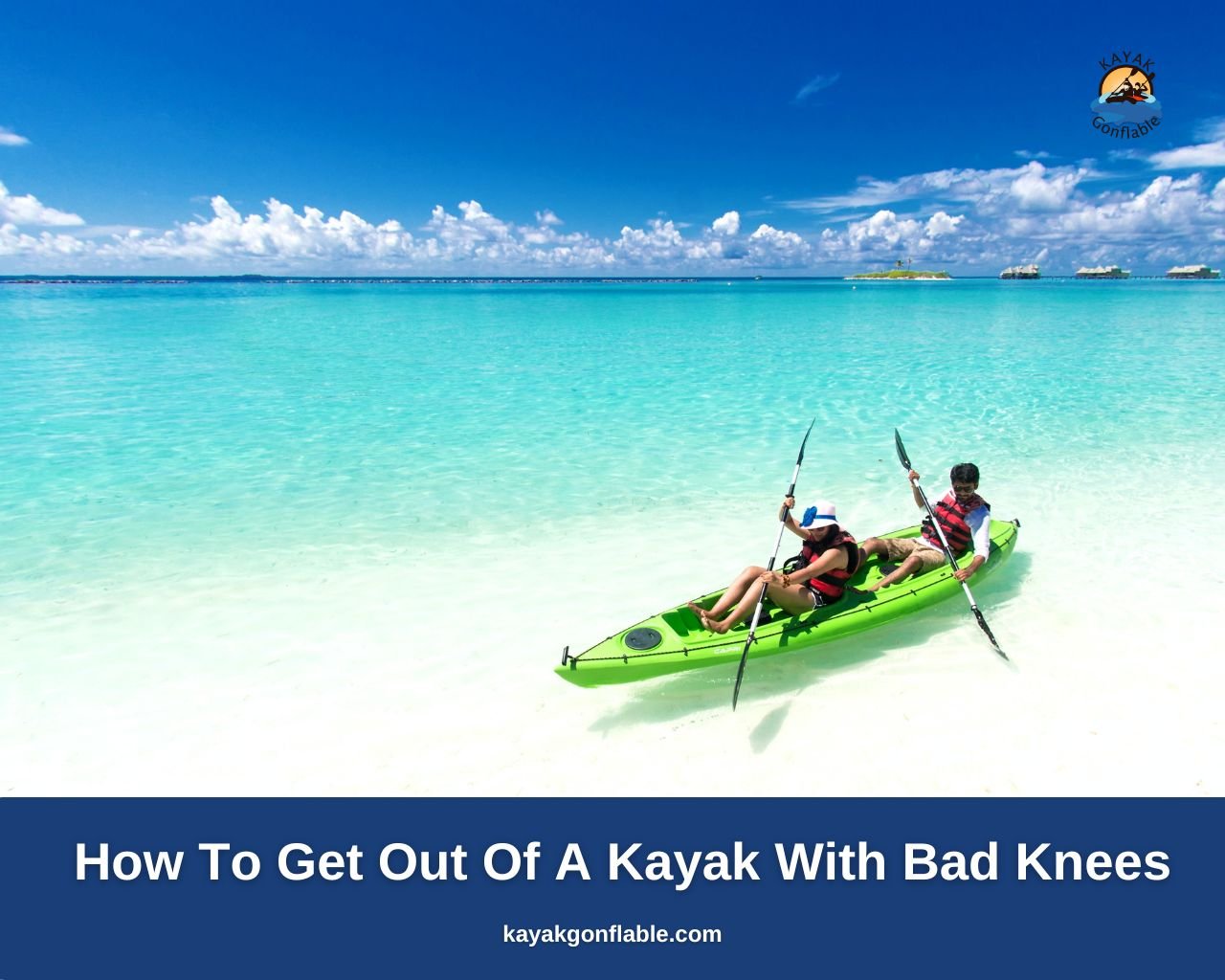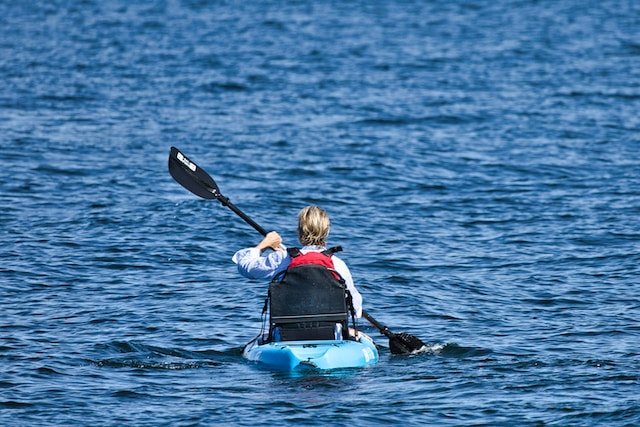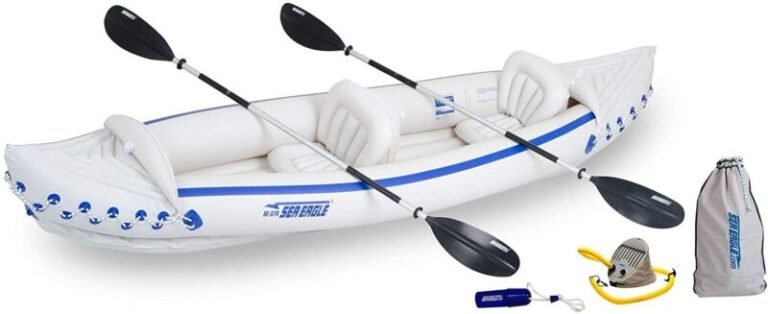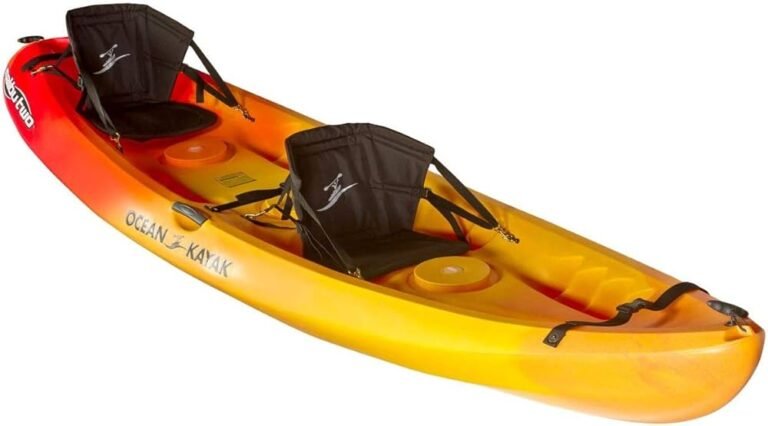Come uscire da un kayak con le ginocchia difettose

Sebbene il kayak sia uno sport divertente con la pagaia, come tutte le cose, presenta anche alcuni aspetti complicati, uno dei quali è entrare e uscire dal kayak. Questi sforzi apparentemente banali non sono le cose più facili da realizzare nemmeno per i kayakisti perfettamente sani.
Quindi, se hai problemi alle ginocchia, è un dato di fatto che avrai difficoltà a entrare e uscire dal kayak.
Per fortuna, nel corso degli anni sono stati inventati diversi consigli per rendere la fatica sopportabile e rendere la salita e la discesa dal kayak il più indolore possibile, così non devi rinunciare al tuo sport preferito solo perché le tue ginocchia non sono così forti come lo erano.
Oggi esamineremo il kayak con le ginocchia danneggiate e i consigli che dovresti tenere a cuore per rendere la tua esperienza il più confortevole possibile. Continua a leggere e ricorda: non devi rinunciare alle gioie del kayak a causa di problemi alle ginocchia.
Come uscire da un kayak con le ginocchia difettose
Dopo essere salito con successo sul kayak e aver remato a tuo piacimento, è ora di uscire dal kayak e affrontare il resto della giornata.
Sapere come uscire dal kayak in sicurezza è molto importante se hai problemi alle ginocchia, poiché qualsiasi mossa sbagliata potrebbe esercitare una pressione inutile sulle tue ginocchia e provocarti un mondo di dolore.
Di seguito vengono spiegati alcuni metodi di uscita per semplificarti la vita, quindi continua a leggere e scegli quello che funziona meglio per te. Ricordati di praticare le tecniche di uscita in condizioni controllate prima di sceglierne una e di doverla eseguire in tempo reale.
L'uscita in acque poco profonde
Come suggerisce il nome, questa tecnica di uscita avviene in acque poco profonde, quindi è necessario evitare che la prua del kayak raggiunga la battigia o la riva.
La profondità dell'acqua dovrebbe essere compresa tra 6 e 12 pollici e puoi misurarla con la pagaia (puoi segnare prima la distanza richiesta con un pennarello indelebile o altra sostanza).
Una volta che tutto è a posto, fai oscillare le gambe su entrambi i lati del kayak (non importa da che parte), quindi gira il corpo finché non sei perpendicolare al kayak.
Successivamente, ti avvicini al bordo del kayak e puoi utilizzare la pagaia come supporto oppure lasciarla cadere e spingere fuori dal kayak per alzarti. Dato che sei già seduto in acque poco profonde, alzarti diventa più facile e senti meno sforzo.
L'uscita per nuotare
Come suggerisce il nome, questa tecnica di uscita richiede di fare una nuotata, quindi dovresti usarla solo nelle giornate calde o quando non ti dispiace bagnarti. La tecnica si svolge in acque poco profonde, profonde circa la vita, ovvero circa la metà della lunghezza della pagaia.
Poiché la tecnica richiede di fare una nuotata, assicurati di farlo giubbotto di salvataggio sia montato correttamente e l'acqua sia priva di ostacoli. Non vorrai ferirti adesso.
Successivamente, devi far rotolare il tuo corpo fuori dal kayak e immergerti nell'acqua. In altre parole, capovolgi la nave e poi fai una nuotata.
Poiché ti trovi in acque poco profonde, riuscirai facilmente a trovare il terreno con i piedi e potrai alzarti in piedi con uno sforzo considerevolmente minore sulle gambe. Ancora una volta, puoi usare la pagaia come supporto se lo desideri per rendere più semplice il processo di alzarsi in piedi.
Rotolamento fuori dal tuo kayak correttamente senza ferirsi richiede un'adeguata conoscenza dell'uscita bagnata, quindi assicurati di rispolverare prima di tentare questa tecnica. Puoi quindi spingere il tuo kayak a riva.
L'aiuto di un amico Esce
Se vai in kayak con un amico con le ginocchia migliori e non vuoi bagnarti, allora questa tecnica di uscita fa al caso tuo. Il metodo prevede di remare con maggiore velocità man mano che ci si avvicina alla riva, in modo tale che una parte dello scafo poggi sulla terraferma.
Successivamente, lascia cadere la pagaia e fai oscillare le gambe su entrambi i lati del kayak, in modo tale da essere perpendicolare alla nave. Ora chiama il tuo amico e aspetta pazientemente il suo arrivo.
Una volta arrivato, il tuo amico dovrebbe assumere una posizione stabile con i piedi larghi e le ginocchia piegate. Dovreste quindi tenervi gli avambracci l'uno dell'altro e fare il conto alla rovescia insieme per sincronizzare i movimenti.
Quando siete entrambi pronti, il vostro amico vi solleverà e non vi lascerà andare finché non sarete sicuri di non perdere l'equilibrio.
Dato che la maggior parte delle spiagge e delle coste sono inclinate, ci sarà uno sforzo maggiore sul ginocchio in discesa quando esci dal kayak, quindi assicurati che il tuo ginocchio buono sia quello in discesa.
Supponiamo, ad esempio, che il tuo ginocchio destro sia peggiore del sinistro, vorrai uscire dal kayak da sinistra in modo che il tuo ginocchio sinistro subisca lo sforzo maggiore e viceversa.
L'uscita per la scansione
Questo metodo dovrebbe essere la tua ultima risorsa. Proprio come nel metodo precedente, guadagni slancio mentre ti avvicini alla costa, in modo tale che una parte dello scafo sia sulla riva, e fai oscillare le gambe su un lato della nave.
Ora, se riesci a gestirlo, metti le mani sul lato dello scafo e le usi come supporto mentre ti alzi lentamente in piedi. Se il tuo problema al ginocchio non è così grave, dovresti essere in grado di gestirlo. Ma se è vero il contrario, striscerai fuori dal kayak, come suggerisce il nome della tecnica.
Una volta che sei seduto perpendicolare al kayak e i tuoi piedi sono su un lato del kayak, rotoli verso la riva in modo tale che la tua pancia sia sul kayak in una posizione simile a quella di qualcuno che cade dal kayak e semplicemente si rimise in sesto.
Successivamente, ti alzi delicatamente su mani e ginocchia e strisci verso un punto dove puoi stare facilmente in piedi. Sebbene questo metodo dia spettacolo a chi ti circonda, è innegabile che funzioni, soprattutto se non c'è un volto familiare in giro e non vuoi chiedere aiuto.
Detto questo, devi semplicemente chiedere aiuto a qualcuno e non dovrai dare spettacolo. Sebbene alcune condizioni mediche possano impedirti di provare le gioie del kayak, a parte i casi estremi, le ginocchia cattive non fanno parte di quella lista.
Rendere la tua prova il più confortevole possibile, tuttavia, dipende da te, quindi assicurati di peccare per eccesso di cautela. Adotta pratiche di kayak sicure e non superare i tuoi limiti e starai bene.
Come andare in kayak con le ginocchia difettose
Se sei una persona che ama la vita all'aria aperta e hai problemi alle ginocchia, potresti pensare che i giorni trascorsi in kayak siano ormai alle spalle. Ma non temere mai! Esistono modi per aggirare il dolore al ginocchio e tornare in acqua.
Con un po' di impegno e creatività, puoi trovare un modo per andare in kayak con le ginocchia danneggiate. Di seguito sono riportate alcune linee guida che dovresti seguire se hai problemi alle ginocchia per rendere più facile il tuo calvario.
Ottieni il consiglio del tuo medico
Che tu sia un appassionato kayakista che di recente ha iniziato a sentire dolore alle ginocchia o che tu abbia già problemi alle ginocchia e speri di iniziare a fare kayak, dovresti prima di tutto visitare il tuo medico.
Il tuo medico sarà in grado di dirti quanto sono danneggiate le tue ginocchia e la probabile causa. Ti illuminerà anche sulle cose da fare e da non fare nella tua situazione in modo che tu possa prenderti meglio cura di te stesso.
Se stai appena iniziando a sentire il dolore, visita il medico per evitare di peggiorare la tua situazione. E se hai intenzione di iniziare a fare kayak con le ginocchia malate, lascia che il tuo medico ti indichi il modo migliore per farlo.
Remare è un'attività faticosa e ottenere l'ok del medico può essere molto utile per tranquillizzare la mente e assicurarsi di essere in buona salute.
Scegli il kayak giusto
Dato che hai già problemi alle ginocchia, vivere un'esperienza piacevole in kayak può dipendere in gran parte dal tipo di kayak che scegli.
Sebbene i kayak sit-in siano fantastici e ti proteggano dagli elementi, il design della cabina di pilotaggio chiusa non è la soluzione migliore per te, quindi ti consigliamo di utilizzare un kayak sit-on-top.
Se sei un appassionato kayakista che ha appena sviluppato problemi al ginocchio, probabilmente puoi continuare a utilizzare un kayak sit-in; è solo che il design del pozzetto aperto dei kayak sit-on-top ti sarà più comodo poiché avrai più libertà di muoverti come preferisci, il kayak ti sostiene, mettendo così meno sforzo sulle ginocchia; e, cosa più importante, è più facile entrare e uscire dai kayak sit-on-top.
I kayak gonfiabili sono una buona scelta per chi ha problemi alle ginocchia?
Tutte le cose considerate, kayak gonfiabili sembrano essere un'ottima scelta per un kayaker con le ginocchia malate. Sono molto stabili, possono essere facilmente trasportati e immagazzinati e possono essere utilizzati in un'ampia gamma di condizioni dell'acqua.
L'unico difetto qui è che, a meno che non abbiano un pavimento ribassato, può essere difficile entrare e uscire, il che è un grosso problema per le persone con problemi alle ginocchia.
Il verdetto dipende quindi dalla gravità del tuo disagio. Siediti sopra kayak gonfiabili dovrebbe dare a qualsiasi kayakista con problemi alle ginocchia il meglio di entrambi i mondi, ma se sei ancora preoccupato per il disagio, puoi sempre procurarti un kayak gonfiabile con un pavimento ribassato.
Ottieni l'attrezzatura giusta
Questo punto non può essere sopravvalutato. Per sfruttare al meglio la tua esperienza in kayak e renderla il più confortevole possibile, dovresti procurarti l'attrezzatura giusta, anche se ciò significa dover spendere di più.
Ottieni attrezzature di qualità, tra cui kayak, pagaia, sedile con schienale di supporto, ginocchiere e altre attrezzature importanti. Forse più importante che procurarsi l’attrezzatura giusta è sapere come usarla.
Assicurati di sfruttare al massimo la tua attrezzatura utilizzandola correttamente e vivrai un'esperienza di pagaiata piacevole.
Fai esercizi di stretching
Che tu ci creda o no, gli esercizi di stretching aiutano a sciogliere i muscoli e renderanno la tua esperienza di pagaiata più piacevole.
Dato che la parte inferiore del corpo resterà ferma per gran parte dell'avventura, muoversi successivamente può essere piuttosto difficile, soprattutto per le persone con problemi alle ginocchia.
Noterai che gli esercizi di stretching ti aiutano a riscaldarti e a rendere molto più facili i movimenti dopo aver remato. Se è passato un po' di tempo dall'ultima volta che sei andato in kayak, assicurati di fare stretching e di riscaldarti prima di entrare in acqua e le cose saranno più facili.
Se vai spesso in kayak, coltiva l'abitudine di fare stretching ogni giorno prima e dopo la tua avventura in canoa e noterai che la tua coordinazione migliorerà con il tempo.
Ottieni coaching o formazione
Questo potrebbe non applicarsi al tuo caso se sei un kayaker esperto che ha problemi alle ginocchia, ma se sei nuovo al kayak, prendere lezioni private da un kayaker esperto può fare molto per aumentare la tua sicurezza.
Molti istruttori di kayak hanno dovuto aiutare le persone con disabilità a godersi il kayak, quindi avranno l'esperienza e le conoscenze necessarie per aiutarti.
L'allenatore può aiutarti a scegliere l'attrezzatura migliore per te e praticare le tue tecniche di pagaiata sotto un occhio esperto è sempre un ottimo modo per migliorare le tue abilità.
Scegli con cura i punti di lancio e atterraggio
La cautela diventa la tua migliore amica se sei un kayaker con problemi al ginocchio e uno dei modi migliori per assicurarti un viaggio tranquillo è scegliere saggiamente i punti di decollo e atterraggio.
Assicurati di varare sempre il tuo kayak in acque poco profonde, lontano dal traffico delle barche, per evitare di essere colpito da qualcuno. Assicurati che il punto di lancio non sia lontano dal tuo veicolo e, se lo è, assicurati di utilizzare un carrello per kayak per renderti le cose il più semplici possibile.
Il tuo punto di lancio dovrebbe anche essere facilmente accessibile agli altri in acqua in modo che possano facilmente darti una mano se hai bisogno di aiuto.
Solleva le gambe mentre remi
Anche le persone in perfetta salute sperimentano un irrigidimento dei muscoli quando mantengono una posizione per un lungo periodo di tempo e una corrispondente difficoltà quando cercano di muoversi, quindi chi ha problemi alle ginocchia può aspettarsi una prova peggiore.
Quando vai in kayak, in genere ti siedi e lasci le gambe in posizione mentre remi. Il risultato è che il sangue può accumularsi intorno alle ginocchia e ciò costituisce un'esperienza spiacevole quando sei pronto per uscire dal kayak, soprattutto se hai problemi alle ginocchia.
Fortunatamente, puoi risparmiarti questa dura prova sollevando le gambe mentre remi ed evitando che il sangue si accumuli attorno alle ginocchia o, per lo meno, riducendo la quantità di sangue che si accumula attorno alle ginocchia.
Puoi sollevare le gambe semplicemente posizionando una borsa impermeabile, uno zaino o un altro oggetto morbido sotto le ginocchia mentre remi e te ne sarai grato quando arriverà il momento di uscire dal kayak.
Non sforzarti troppo
Un ottimo modo per assicurarti che tutto vada bene alla fine della giornata è conoscere i tuoi limiti e non superarli. Ciò implica regolare la distanza percorsa in kayak durante ogni viaggio.
Maggiore è la distanza percorsa, maggiore è la tendenza a ritrovarsi con le ginocchia rigide alla fine della giornata, quindi assicurati di sapere cosa stai facendo.
Se sei un appassionato kayakista che ha sviluppato problemi al ginocchio, puoi iniziare a valutare i tuoi limiti percorrendo in kayak la metà della distanza che faresti normalmente e continuare a spingere i limiti un po' alla volta in modo da sapere quanto tempo è sicuro trascorrere sull'acqua e attenersi ad essa.
Se sei nuovo al kayak e hai problemi alle ginocchia, ti consigliamo di farlo per un po' con un kayaker esperto in modo da poter scoprire i tuoi limiti in un ambiente controllato.
Parte del non spingersi troppo è scegliere con cura il corpo d'acqua in cui si va in kayak. Questo potrebbe essere difficile per alcune persone, in particolare per i kayakisti esperti che sono abituati a navigare nelle rapide delle acque bianche.
Anche se non devi rinunciare del tutto alla tua passione, cerca di essere cauto mentre ricordi che i tuoi problemi al ginocchio significano che potresti non essere in grado di eseguire con successo alcune delle manovre audaci che una volta potevi e agisci di conseguenza.
Il kayak può essere praticato anche in acque calme ed è inutile esporsi inutilmente a rischi.
Non esitate a chiedere aiuto
Avere le ginocchia malate fa schifo, soprattutto quando inizi a pensare al fatto che non sarai più in grado di fare molte cose con la stessa facilità di una volta.
Questo può essere travolgente, soprattutto se stai facendo kayak in un luogo senza un volto familiare, e restare per conto tuo, indipendentemente da ciò che accade, potrebbe sembrare l'opzione più sicura.
Ti sto dicendo ora che il tuo orgoglio non vale la tua sicurezza. È davvero ammirevole che tu non abbia lasciato che i tuoi problemi al ginocchio si frapponessero tra te e il tuo sport preferito.
Quindi fai il prossimo passo di coraggio e chiedi aiuto ogni volta che ne hai bisogno. Anche se tutte le persone che incontrerai potrebbero non essere del tutto amichevoli, troverai sicuramente qualcuno che sarà felice di aiutarti.
Inoltre, non hai lasciato che le ginocchia rotte ti facessero abbandonare il kayak, quindi perché dovresti lasciare che l'orgoglio abbia la meglio su di te? Fatevi un favore e chiedete sempre aiuto quando ne avete bisogno.
Come entrare in un kayak con le ginocchia difettose
Come entrare in sicurezza in un kayak è un'abilità che tutti i kayakisti dovrebbero padroneggiare, in particolare quelli con problemi al ginocchio. Questo perché non dovrai preoccuparti di scendere dal kayak se non riesci a salirci sopra.
Per coloro che hanno problemi al ginocchio e vogliono entrare in sicurezza nella propria moto d'acqua e godersi lo sport che amano, di seguito viene fornita una linea guida passo passo per salire su un kayak.
- Trova un punto di lancio appropriato in acque poco profonde. L'acqua dovrebbe essere alta fino alle ginocchia o metà della lunghezza della pagaia.
- Posizionare il kayak perpendicolare alla riva o alla costa.
- Posizionati su entrambi i lati del kayak e posizionati qualche centimetro davanti al sedile.
- Ora getta una gamba sul kayak in modo da stare a cavalcioni con un piede a terra su ciascun lato.
- Successivamente, devi mantenere il kayak in posizione per aiutarti a mantenere l'equilibrio. Puoi farlo da solo tenendoti ai lati dello scafo o, meglio ancora, puoi chiedere a qualcuno di tenere fermo il kayak per te.
- Ora, a seconda del lato del kayak su cui ti trovi, puoi abbassarti sul sedile dietro di te o scivolare in avanti sul sedile del kayak.
- Successivamente, usi le braccia per sollevare le gambe da terra e metterle nel kayak.
- Ora puoi spingerti al largo con la pagaia e goderti la tua avventura






